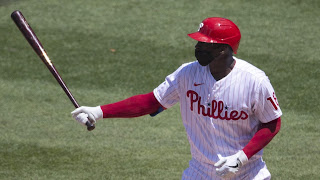 |
| Phillies Opening Day - April 3, 2021 (frontline workers honored) |
2021 was both my best and my worst year as a Phillies fan.
Before the season began, I was chomping at the bit to go to
a live, professional baseball game. We had been denied that glorious experience
the year before when the coronavirus pandemic shut down the world. My last game
was in July, 2019. That felt like a lifetime ago.
I began buying tickets with reckless abandon. By season’s
end, I had attended nine Phillies games and 12 major league games
overall in four different stadiums. I also added three minor league games to
the mix. By the summer, ballparks returned to full seating capacity, and those
of us who were vaccinated gladly ditched the masks.
All was not rosy outside of baseball land, however, as my dad suddenly passed away in July at the age of 66. I owed my love of the game to him, and my level of gratitude was such that I even wrote a book about it. We finally crossed the last big item off our baseball bucket list in April when we went to Opening Day at Citizens Bank Park. At the time, it felt important after a year of being stuck at home.
The pandemic filled everyone’s future with a
sense of uncertainty. I think we began approaching life with more of a “seize
the moment” mentality, and we’re all the better for it. Dad and I got to go to
one more Phillies game together before his untimely passing, and that honestly
made accepting his death a little easier.
Going to nine Phillies games in one season (my previous
record was six), I definitely experienced things I’d never seen before. I was
there for Aaron Nola’s complete-game shutout in April, and it was one of two Phillies shutouts
I saw. I’d only attended one other Phils shutout before 2021.
I sat through my first rain delay ever, and another game was
suspended to the following day due to thunderstorms. Both times, the Phillies provided
me the option of purchasing heavily discounted tickets to future games, which I
jumped on. The team also offered a flash sale of $8 tickets after an eight-game
winning streak in early August. I very quickly realized the perks of being a die-hard
Phillies fan.
Then again, by the time August rolled around, I began
wondering if the Phillies had any die-hard fans left.
As I mentioned earlier, I saw games in four different
stadiums in 2021. It’s always nice to immerse yourself in the fan atmosphere in
another city. Unfortunately, my travels and the sense of loss I felt at Citizens Bank Park after my dad died made me realize that the Phillies have
one of the most apathetic fanbases around.
I went to Citi Field in June, and every Met fan in that
stadium was riveted by every play and every pitch, and I felt the same
vibe when thousands of them flocked to Citizens Bank Park to
watch the Phils sweep their team out of first place. Hell, I felt more fan
participation at Camden Yards, and the Orioles were the worst team in baseball.
At Citizens Bank Park, the fans cheered louder when a fellow fan caught a foul
ball than the last out of a win. I realize Philly is a football town, but come
on, give me something!
Simply knowing that I could get a better fan experience
somewhere else, I won’t be going to as many Phillies games in 2022, and that’s a
shame. 2021 will wind up being the exception, rather than the rule. It also ended on a high note, as J.T. Realmuto crushed a walk-off
double at my ninth and final Phillies game in September. At least the fans lost
their minds for that play.
The 2021 season featured a little bit of everything, including
every emotion on the spectrum. I will look back on it with fondness and
heartache, and now that it’s over, I only have question: is it April yet?!



